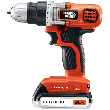If you make your home more energy efficient, not only will you save money on your gas and electric costs, you will also help the environment. While it may be easier to turn the thermostat up if you feel a draft, it is more cost-advantageous—and eco-friendly—to find the source of the air leak and repair it. Here are some great ways for creating a more energy-efficient home:
Use common sense when thinking about how to use energy more efficiently. Instead of heating up the oven range, use your microwave oven to cook foods. Switch out your old computer for a sleek laptop, which uses less energy. In nice weather, hang your clothes to dry instead of using a clothes dryer. Use outdoor solar lighting instead of electrical lighting. If you see damaged or cracked caulking around windows, replace it so to cut down cold drafts in the winter, and air conditioning loss in summer. Hang drapes at your windows during all seasons to help insulate rooms.

MAX Power! A powerful lithium-ion drill/driver that delivers 0-to-650 RPM and 115 inches-per-pound of torque in a lightweight, easy-to-use package. An anti-slip soft grip and LED worklight makes this tool a delight to use. Check out Black & Decker 20-Volt Cordless Drill/Driver today!
Insulation is one of the best ways possible to help make your home comfortable. Not only does insulation help heat your ...
Discover MoreIf you are looking to create a home that is energy efficient, you really can't afford to overlook the doors of your home. ...
Discover MoreIf you want to stretch your energy dollar even farther, place your CFLs on a dimmer, timer, or motion sensor switch. That ...
Discover MoreThere are currently no comments for this tip. (Be the first to leave your comment—just use the simple form above!)
Copyright © 2025 Sharon Parq Associates, Inc.
Comments